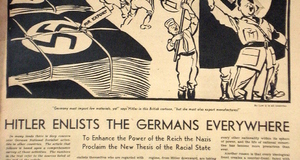Featured Article:Sociolinguistic Bias in AP Style: How News Media Deny African American Vernacular English Realities5. News Compartmentalization in SAE and AAVE MediaIn addition to ignoring AAVE lexicon and syntax, news media that follow AP style also transmit reality less intelligibly for AAVE speakers through the ways in which they organize information. As I have shown, dominant-realistic news media categorizations both support SAE speakers psychologically and neglect non-SAE speakers and their lived experiences; AP style-directed news media offer lucid portrayals of reality for SAE speakers and those who accept the generic cues through which it advances narratives. I now argue that the ways in which news outlets organize information demonstrate for whom they orient their content, and that those that follow AP style prioritize SAE communities in this regard. I consider two manners by which news media organize their material: production segmentation and AAVE contextualization. I offer data from a survey of journalistic outlets that serve African-American communities and mainstream news media, along with formal analyses of articles by the Minnesota Spokesman Recorder (MSR) and Minnesota Star Tribune, as evidence. The first means by which news media that follow AP style organize their productions to prioritize SAE texts is the segmentation of information. Orgad discusses this dynamic: “News…produces highly conventionalized versions of reality by (among other representational and editorial techniques) classifying events into compartments…and considering their treatment and solutions only within these categories” (92). Orgad shows that news categorizations represent information subjectively and frame reality intentionally. For example, presenting a story in the entertainment section, rather than the national politics section, regardless of the piece’s content, may cause the viewer to consider the piece’s content to be less serious. Publishing an article on the front page of an issue instead of on the last page may indicate to the reader that it is more significant. Essentially, the organizational structure of news media productions—both the generic cues within and the segmentation without—influence how and whether they relay reality for the viewer. Consistent discrepancies in segmentation between African-American newspapers (i.e., those newspapers which cater primarily to readers of African-American descent) and mainstream SAE news media that follow AP style further demonstrates the latter’s sociolinguistic bias against AAVE speakers. While not all African-Americans speak AAVE, sociolinguistics and historical linguistics literature generally embraces the Neo-Anglicist hypothesis, which maintains that contemporary AAVE derives from British English and diverges from SAE due to social and economic segregation between African-Americans and European-Americans (Ash & Myhill, 1986; Labov & Harris, 1986; Myhill and Harris, 1986; Bailey & Maynor, 1987; Montogmery & Fuller, 1996; Labov, 1998; Poplack, 2000). African-American newspapers target AAVE speakers because the language is primarily rooted in African-American communities. This focus on AAVE speakers partially influences how they compartmentalize information.In order to test how segmentation of news productions varies for mainstream and AAVE audiences, I conducted a survey (see Appendix) of 40 randomly selected print publications from African-American and popular newspapers that examined categories by which they segment information. I referenced lists of newspapers from the Pew Research Center and the National Newspaper Publishers Association to identify African-American newspapers and the Alliance for Audited Media’s “Top 25 U.S. Newspapers for March 2013” to gather mainstream publications. I then determined whether each publication had a section on the homepage of its website, represented with a main tab or dropdown menu tab on its homepage, for the following categories: Editorials/Opinions; Arts & Entertainment; Health; Business; Community; Sports; Religion; Black Experience; Politics; Education; Auto/Cars; Crime; Science & Technology; Real Estate; and Markets & Economy. The data highlights several points of divergence in terms of news segmentation between mainstream and African-American newspapers. Two of the abovementioned categories, Religion and Black Experience, are regularly present in news media that focus on African-American readers and generally absent from mainstream media. 55 percent and 65 percent of the African-American newspapers that I surveyed have sections on Religion and Black Experience, respectively. In contrast, 20 percent of mainstream productions surveyed have a Religion section and none have a Black Experience section. Moreover, four categories are notably more prevalent in mainstream newspapers. Among the mainstream publications, all have an Auto & Cars section, 90 percent have a Real Estate section, 60 percent have a Crime section, and 60 percent have a Markets & Economy section. Conversely, 20 percent of the African-American publications have an Auto & Cars section, none have a Real Estate section, 20 percent have a Crime section, and none have a Markets & Economy section. These discrepancies suggest that both groups of publications represent information subjectively, and that mainstream media relay reality less intelligibly for African-American, and thus AAVE audiences. In addition to organizing information in particular ways, segmentation of information fosters specific realities via “strategies of containment.” Fiske argues that the ways in which news media organize information through particular categories determines what information informs the realities they promote: “…the telling of stories and the selection of the key events are clearly cultural activities….The popularity of the news is determined largely by its generic characteristics which constitute the strategies of containment which attempt to control ‘reality’” (283). The segmentation of mainstream news productions determines what categories warrant public attention, as well as which headlines are relevant within each section. By eschewing sections that are pertinent to African-American communities, such as those that discuss religion or experiences within Black communities, the realities that mainstream news media convey may completely disregard information of significance to AAVE-speakers. News media that follow AP style also organize their productions to prioritize SAE texts through their contextualization of AAVE; when publications allow the use of AAVE, the contexts in which it appears cue the reader to understand it as a non-standard variety that is appropriate only in certain circumstances. This portrayal of AAVE relates to commentary Hall (1997) provides on the ways in which mainstream media represent Black bodies: “On the front page headlines, black males become highly visible as a threat to white society, as muggers, rapists, terrorists and guerillas….But turn to the back pages, the sports pages, and the black man’s body is heroized and lionized…they’re not Other…they’re our boys” (288). Expressions of Blackness in sports pages mask the predominant portrayal of Blackness in mainstream newspapers as threatening and offensive. Productions that follow AP style similarly permit usage of AAVE in certain contexts, such as an opinion section or a letter to the editor, but otherwise forbid it. Minnesota Spokesman-Recorder Managing Editor Vickie Evans-Nash explains that, while her newspaper seeks to present news in a manner that is relatable to AAVE audiences, it only publishes AAVE material in its Entertainment and Opinion sections: “When we write news stories, we are very conscious of AP style. The grammar we use is strict…in some opinion pieces we hold true to the writer’s voice; in those instances when it’s not a news story we honor the voice of the writer” (Evans-Nash). The Spokesman-Recorder conveys information in SAE and limits the contexts in which AAVE is appropriate. Hence, contextualization may serve as an additional means by which news media that follow AP style promote sociolinguistic bias. 6. Misrepresentation of AAVE in News MediaHaving discussed how mainstream news media that follow AP style neglect AAVE lexicon and syntax and organize information in ways that alienate AAVE speakers, I now examine ways in which these publications misrepresent the language pejoratively as a type of incorrect English. Green notes that mainstream media have historically explained AAVE incorrectly: “Different linguistic strategies are used in the media to mark the language of black characters. Often, current slang and lexical elements are used, especially if the characters being portrayed are in certain age groups….[S]alient features…accurate or not may also be used” (200). She offers the example of the habitual aspect auxiliary ‘be’ and The New Yorker writer Louis Menand’s description of its meaning in reference to a story on the Oakland Ebonics case in 1997: “Menand explains that be is used…as in ‘Johnny be good,’ meaning ‘Johnny is a good person’… the characterization…provides little insight into the meaning indicated by be. In simple terms, it is unlikely that the meaning of Johnny be good is ‘Johnny is a good person’” (35). Rather than acknowledging the habitual aspect that the AAVE auxiliary ‘be’ signifies (i.e. “Johnny be good” as meaning “Johnny is usually good”), Menand misinterprets it as having the SAE copula meaning, implying that the speaker has failed to conjugate it correctly. This example illustrates how mainstream media may misrepresent AAVE as improper SAE, thereby delegitimizing it and promoting sociolinguistic bias. Another way in which news media that follow AP style misrepresent AAVE is by translating it into SAE entirely when a story includes the commentary of AAVE speakers. Evans-Nash explains that while the Spokesman-Recorder permits AAVE in opinion and entertainment pieces, mainstream news media like the Minneapolis Star Tribune make no such allowances. She offers the example of Sheletta Brundidge, a Spokesman-Recorder contributing writer who has submitted Entertainment pieces in AAVE. The following are excerpts from Brundidge’s (2010) “Bristol wins, Brandy loses”: “‘Momma,’ I interrupted, ‘you know I don’t watch those reality shows. I hardly watch any TV, and I ain’t seen five seconds of an episode of no Dancing with the Stars’… ‘that heffa can’t even dance!’…‘White folks don’t have time for hope, ’cause they voting, they taking action.” These excerpts include three examples of AAVE lexicon—‘momma’, ‘heffa’, and ‘’cause’—and two examples of AAVE syntax—multiple negation and the omission of the copula main verb ‘be’. While Brundidge uses these and other elements of AAVE throughout her writing, when the Star Tribune published one of her articles, “Sheletta Brundidge: At Last, Our Princess Has Come” (2009), the mainstream news outlet translated it all into SAE. The following are excerpts from this piece, as it was published in the Star Tribune: “…girls who will never be told they are princesses—real-life girls like Precious, the ones who don't have anyone to tell them they're special…they were funny … she saw parts of herself on the big screen. I'm 37 years old. I'm a wife, a mother, a businesswoman.” This passage is at odds with several AAVE syntactic conventions. For example, there is no use of multiple negation. This is especially surprising in the phrase, “the ones who don’t have anyone,” which would probably read, “the ones who don’t have no one” in AAVE. Moreover, there is no omission of relative pronouns or the copula ‘be’. ‘Mother’ even replaces ‘momma’ in the Star Tribune piece. Brundidge’s case shows that, unlike African-American newspapers, mainstream news media that follow AP style filter AAVE out of entertainment and opinion stories, prioritizing SAE and promoting sociolinguistic bias. 7. Codependency of Journalism and State InstitutionsThe sociolinguistic bias of news media that follow AP style contributes to symbiotic associations between mainstream journalism and state institutions, including the political system, military, and legal system. In this section, I discuss how the journalism industry’s relationships with these institutions both depend on linguistic and narrative practices and reinforce normative power structures. Relying on McChesney and Nichols’ (2010) The Death and Life of American Journalism and Bennett, Lawrence, and Livingston’s (2007)When the Press Fails, I assert that mainstream journalism’s indexing of narratives from a “golden rolodex” of political officials reinforces the codependency of the journalism industry and U.S. political system. I reference Bennett’s (1988) News: The Politics of Illusion and Chomsky’s (1986) “All the News That Fits” to argue that news media’s discretion over particular uses of lexicon contributes to a symbiotic association with the military industrial complex. I return to Fiske to claim that news media’s “exnomination” of authority figures supports the reciprocity between mainstream journalism and the state legal system. Finally, I conclude this section by revisiting AP style to explain mainstream journalism’s reinforcement of and dependence on the normative sociolinguistic dominance of SAE in light of these other cooperative associations. Mainstream journalism’s indexing of narratives from a golden rolodex of official sources demonstrates its interdependence with the U.S. political system. McChesney and Nichols explain the development of this journalistic trend as a means of reducing the expenses of in-depth investigative reporting: “…journalism as it crystallized…[has] relied far too heavily upon official sources (i.e., people in power) as the appropriate agenda setters for news and…the range of legitimate debate in our political culture” (45). Consequently, journalism is cheaper, but also less responsible and relevant because reporters rarely challenge the sources on whom they depend. As Bennett, Lawrence, and Livingston explain, mainstream outlets inevitably index narratives that these sources provide, vocalizing prominent political figures, regardless of their party affiliation, and silencing opposition without significant political clout: “The core principle of the mainstream press system in the United States appears to be this: …news generally stays within the sphere of official consensus and conflict displayed in the public statements of the key government officials who manage the…decision-making processes” (49). Moreover, in his work Reporters and Officials, Sigal (1973) finds that government officials are the sources of nearly three quarters of all news, and that only one-sixth of news information can be traced to sources outside of government (124). The ubiquity of indexing narratives from a golden rolodex shows mainstream journalism’s biased support of the political system as its favored, legitimate source of information. Apart from financial benefits, an overreliance on the golden rolodex enables mainstream news media to convey a narrative of normativity that is psychologically pleasurable for audiences. Bennett identifies news normalization as one of several “information biases” that prevent mainstream media from assisting in the resolution of social problems. He claims that an official’s declaration that a problem (e.g., The Great Recession) will be resolved somehow is more important than the actual details of the solution: “Thus, the fourth major information bias in the news is the tendency to filter news information through traditional values, beliefs, and images of society and to deliver the filtered information through the reassuring pronouncements of authorities charged with returning things to normal” (52). Thus, both mainstream news media and the political system benefit from a symbiotic relationship that entails the former privileging the narratives from the latter’s official sources. This association reinforces normative power structures, vocalizing those in power exclusively. Another form of sociolinguistic bias in AP style-directed news media, usage of familiar lexicon, contributes to a symbiotic association between mainstream journalism and the military industrial complex. Orgad discusses ‘estrangement’ and contends that national news media naturally prevent their audiences from experiencing it: “…estrangement refers to the ways in which media representations act as invitations to audiences to detach themselves from commonsensical conceptions of their lives in the national context…or the way that media representations make the nation a stranger to itself” (87). Mainstream media tend to use lexicon that portray the military in a positive light because it is not in their interest to estrange and discomfort their audiences. Employing lexicon that represents the military as imperialistic or inhumane would do so by challenging a belief rooted in audiences’ national identity—that their foreign policy is supportive of freedom, humanity, and righteousness, namely. Bennett, Lawrence, and Livingston offer an example of mainstream news media’s lexical bias in their description of torture in the Abu Ghraib prison. The authors explain that the symbiotic relationship between military officials and media outlets caused the latter to label photos of U.S. soldiers physically tormenting inmates as forms of ‘mistreatment’ and ‘abuse’, rather than ‘torture’. They attribute this in part to the saturation of media with military narratives: “By May 19, while the Senate Armed Services Committee held hearings on the ‘abuses,’ the term torture had all but disappeared from the news. The official news narrative was all but complete within two weeks of the dramatic first airing of the photos” (103). Rather than attempt to describe the activities that the Abu Ghraib photos depict objectively, mainstream media deferred to the lexicon that military personnel cued. Chomsky coins the term “historical engineering” to describe the trend of mainstream news outlets using favorable language to describe U.S. military endeavors. He offers examples of news media representations of World War One, World War Two, the U.S. interventions in Guatemala and El Salvador, and the war in Vietnam to show how historical engineering rallies citizens’ support for the military (56). Thus, both mainstream news media and the military industrial complex benefit from a symbiotic relationship that entails the former privileging the latter’s lexicon; this association reinforces normative power structures, affording the military more agency to narrate their activities and less accountability for them. Another narrative technique, the “exnomination” of state authority figures, supports the exchange between mainstream journalism and the legal system. Fiske distinguishes perspectives that are ‘nominated’ and ‘exnominated’ in news media: “Exnomination is the evacuation of a concept from the linguistic system with its structure of difference and alternatives. That which is exnominated appears to have no alternative and is thus granted the status of the natural, the universal, or that-which-cannot-be-challenged” (290). He analyzes a mainstream news media story depicting a standoff between management and union workers to explain the exnomination of the former: “…the union view of the dispute is nominated; but that of the management is exnominated….There is no spokesperson, instead it is the ‘objective’ voice of the news reader which speaks the management sense” (290). News media regularly exnominate legal system authority figures, thereby favoring normative over subversive sources. Mainstream media outlets in turn benefit from exnominating legal system authority figures because doing so makes stories seem legitimate to their audiences. Bennett (1988) explains that news media’s repeated support of particular political values through processes like exnomination makes them appear objective, and thus trustworthy: “The appearance of objectivity or believability depends heavily on the use of official sources and normalizing themes. The routine acceptance of official views helps to legitimize them, which in turn helps make the news seem objective” (61). Mainstream media’s consistent exnomination of legal system authority facilitates a symbiotic relationship because it at once makes both appear legitimate to their audiences; the legal authority appears appropriate because the media outlet implies that its power is natural and universal. In turn, the authority makes the media outlet seem objective by its regular presence within news productions. This relationship reinforces normative power structures because it validates the agency of both. By following AP style and prioritizing SAE, news media further solidify the symbiotic relationships between the journalism industry and state institutions. Favoring commentary from SAE speakers supports the indexing of narratives from a golden rolodex of official sources like U.S. politicians, most of whom are SAE speakers. Prioritizing SAE texts ensures that mainstream media do not estrange their SAE-speaking audience. Furthermore, utilization of AP style supports the exnomination of legal system authority figures by providing a codified, rule-governed language through which to express their ostensibly objective position. Indeed, the consistent exnomination of sources with SAE language furthers sociolinguistic bias because it makes the language variety, like the state legal system appear natural, universal, and unbiased. Hence, the sociolinguistic bias in news media that follow AP style perpetuates symbiotic relationships between mainstream journalism and other state institutions, thereby strengthening normative power structures.Continued on Next Page » Suggested Reading from Inquiries Journal
Inquiries Journal provides undergraduate and graduate students around the world a platform for the wide dissemination of academic work over a range of core disciplines. Representing the work of students from hundreds of institutions around the globe, Inquiries Journal's large database of academic articles is completely free. Learn more | Blog | Submit Latest in Business & Communications |


















